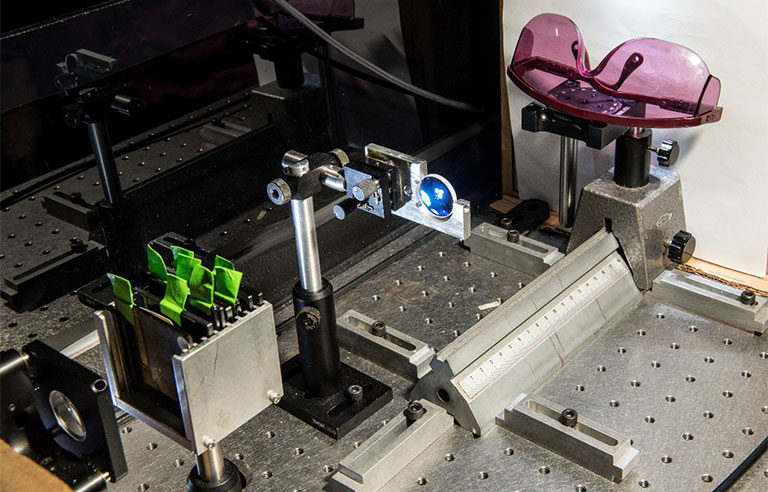Tests find potential light-blocking problems in laser protective eyewear

Measurement set-up: Laser light from the left passes through various filters (green tabs), other apparatus (blue circle), and onto a sample, which is mounted where the rose-colored glasses are here. The light that passes through the sample is measured by a detector (not shown).
Photo: National Institute of Standards and Technology
Gaithersburg, MD — Many laser protective eyewear products may not be adequately tested – by both manufacturers and end users – for lasers that emit high-power, ultrafast pulses, potentially putting workers at risk, according to a study from the National Institute of Standards and Technology.
Researchers analyzed 24 protective eyewear filters from five manufacturers, with each sample rated to block light at a wavelength of 800 nanometers, classified as infrared light hidden from human view. The researchers conducted multiple measurements of optical density and found that the products’ initial testing likely did not allow for high-powered, ultrafast lasers.
Pulses of ultrafast lasers have greater wavelength spans. The range widens as the pulse duration shortens.
Eyewear filters showed different responses to light ranging from 750 nm, or visible red, to 900 nm, or near infrared. Although some showed little variation in response, other filters displayed damage from direct illumination in seconds. One filter blocked a majority of light at 800 nm but was only one-hundredth as effective at 847 nm, the researchers said.
“We are trying to encourage manufacturers to use the best possible testing laboratories to evaluate their lenses,” study co-author and NIST researcher Ted Heilweil said in a Nov. 28 press release. “At the same time, and equally important, we need to get end users to be more aware of the precise wavelengths their lasers are producing. They need to test their eyewear themselves – in the specific conditions and particular applications for which they will be used – before putting them on.”
Heilweil called the study “more like a start-up point,” stressing that more research is needed.
The study was published online in September in the Journal of Laser Applications.
Post a comment to this article
Safety+Health welcomes comments that promote respectful dialogue. Please stay on topic. Comments that contain personal attacks, profanity or abusive language – or those aggressively promoting products or services – will be removed. We reserve the right to determine which comments violate our comment policy. (Anonymous comments are welcome; merely skip the “name” field in the comment box. An email address is required but will not be included with your comment.)

